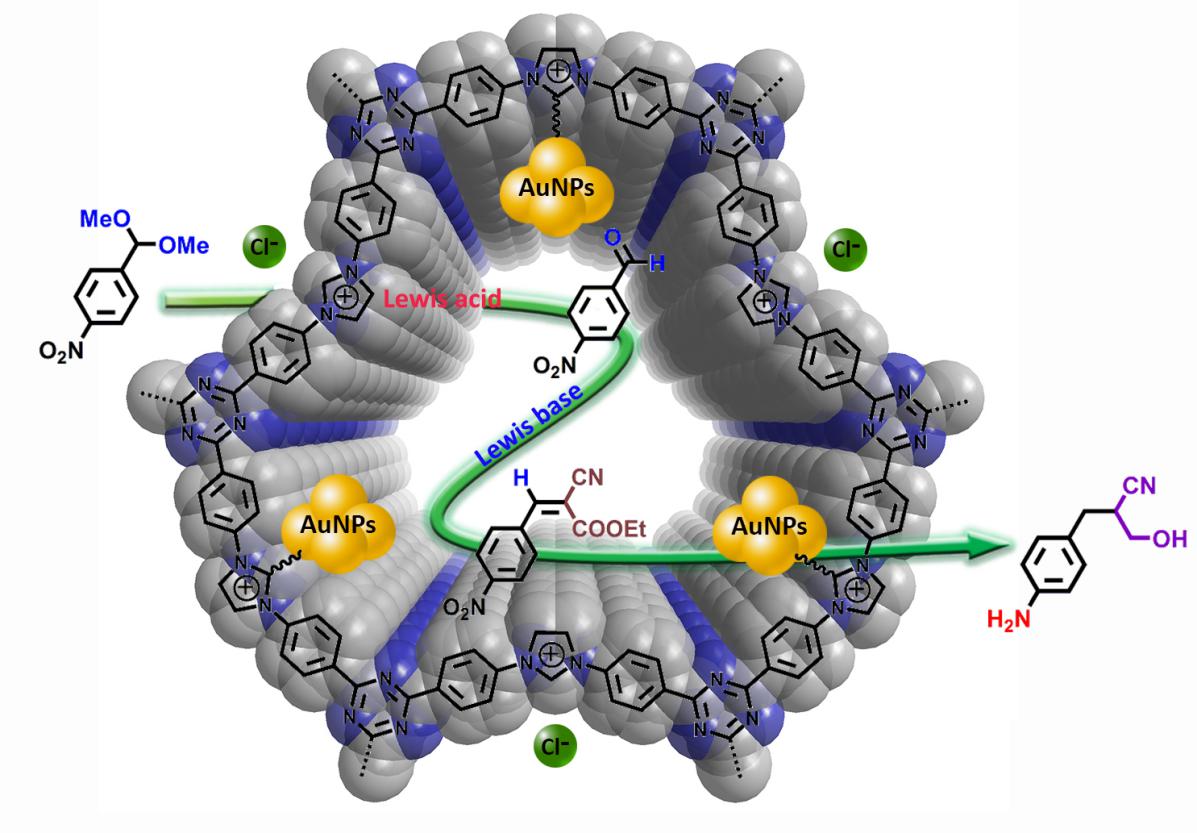
Tandem catalytic reactions have attracted great attentions because of their ability to reduce reaction steps, energy consumption, and waste. However, the construction of highly efficient tandem catalytic systems is a challenge due to the problematic integration of multiple active sites in one reaction system and the incompatibility of different reaction conditions.
In a study published in CCS Chem., the research group led by Prof. CAO Rong and Prof. HUANG Yuanbiao from Fujian Institute of Research on the Structure of Matter (FJIRSM) of the Chinese Academy of Sciences (CAS) reported that ultrafine gold nanoparticles (AuNPs)/imidazolium-functionalized cationic covalent triazine frameworks (ICTFs) composites as multifunctional catalysts can efficiently catalyze a tandem reaction that completed cooperatively by Lewis acid and base sites and Au species.
The researchers first investigated the Lewis acid and base sites of ICTF by performing NH3 and CO2 temperature-programmed desorption (TPD) spectrometry, respectively.
Compared with the neutral CTF-1, ICTF showed a distinct peak in the range of 325-375 K, which could be assigned to NH3 adsorption on the imidazolium cations, validating its Lewis acidity. Meanwhile, a broad visible peak was observed at about 550 K in the CO2-TPD profile for ICTF, attributable to the CO2 adsorption on the free chloride anion and triazinic N, indicating its medium Lewis basicity. These results proved the coexistence of Lewis acid and base sites in ICTF, suggesting that it might catalyze tandem acid-base reactions.
The researchers then encapsulated the highly ultrafine AuNPs in ICTF (Au@ICTF) via a double-solvent method (DSM), followed by reduction with NaBH4. Thanks to the confined space of ICTF, the in situ generated N-heterocyclic carbene (NHC) species and abundant nitrogen atoms, and these tiny AuNPs exhibited excellent catalytic activity in the hydrogenation of p-nitrophenol.
Encouraged by the successful catalysis of single-step reactions by Au@ICTF under similar conditions, the researchers found that the obtained heterogeneous multifunctional Au@ICTF can cooperatively catalyze a three-step tandem deacetalization-Knoevenagel condensation-reduction reaction on the basis of both ICTF Lewis acidity, alkaline and AuNPs, with excellent activity, selectivity and recyclability.
More interestingly, Au@ICTF could achieve a gram-scale synthesis of the target arylamine product containing -OH and -CN groups, monitored by using gas chromatography-mass spectrometry (GC-MS). On the contrary, the neutral CTF-1 and Au@CTF-1 could not promote the tandem reaction efficiently.
These results suggested that the imidazolium groups in Au@ICTF acted as acid-base active sites to promote the deacetalization-Knoevenagel condensation reaction, while the AuNPs active sites played an important role in the reduction reaction, and the proximity of acid-base active sites and AuNPs was critical to work in concert synergistically on a substrate to facilitate the tandem reaction.
The excellent combination of host-guest cooperation in Au@ICTF for the tandem catalysis provides a new way to design and fabricate multifunctional porous catalysts for future green organic synthesis.

The three-step tandem deacetalization-Knoevenagel condensation-reduction reaction catalyzed by heterogeneous multifunctional Au@ICTF (Image by Prof. CAO's group)

86-10-68597521 (day)
86-10-68597289 (night)

52 Sanlihe Rd., Xicheng District,
Beijing, China (100864)

